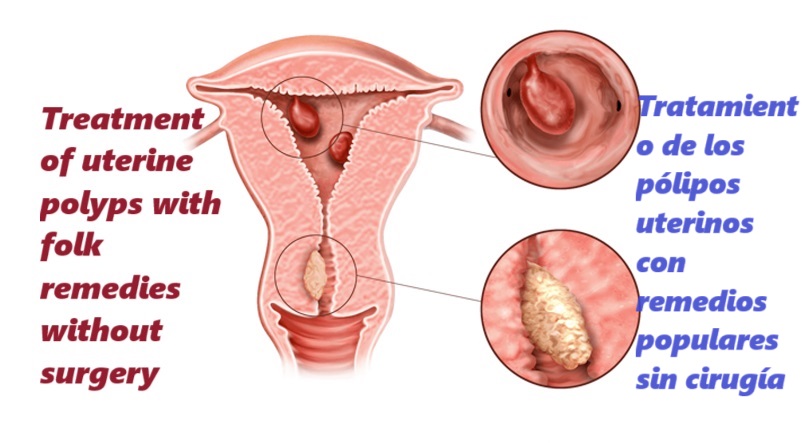First and foremost, it is important to remember that reproductive function is one of the most important aspects of human life, so treating uterine polyps with folk remedies without consulting a gynecologist should be avoided. Only after consulting with a doctor can various recipes be used.
If necessary, folk remedies can be combined with homeopathic treatment. However, some of the widely advertised remedies, considering their extensive list of contraindications, are better left unused altogether.
It has been proven that herbal treatment is much more effective and safe in terms of side effects and negative consequences compared to the use of many homeopathic remedies.
Best folk remedies for uterine polyps
Let’s consider effective and easy-to-prepare folk remedies that can help treat uterine polyps without surgery and without significant interference with the body’s functioning.
Decoction of herbs for regular intake
To prepare this decoction, you will need:
1 teaspoon of black currant berries,
3 teaspoons of cinnamon rose hips,
2 teaspoons of common nettle leaves.
The black currant, rose hips, and nettle should be mixed and finely chopped. Then, take 1 tablespoon of the resulting mixture and pour it with 2 cups of boiling water. Let it infuse for an hour and strain through cheesecloth (during this time, the infusion will reach almost room temperature).
If the taste is too bitter, you can add a little sugar – it will not affect the properties of the decoction. Take it 4 times a day at any time, drinking half a cup each time. This recipe works well for treating cervical polyps.
Herbal decoction for douching
Polyps on the surface of the endometrium can arise from various causes, one of which is the disruption of natural hormonal balance due to a lack of nutrients. This situation can be corrected by using the following decoction. It should be used in case of vaginal discharge.
You will need:
2 tablespoons of common wormwood herb,
2 tablespoons of rosemary leaves,
2 tablespoons of sage leaves,
4 tablespoons of common oak bark.
All these components should be finely chopped and mixed in an enamelware pot. Then, pour boiling water over it in a volume of 2.5 liters and bring to a boil. The decoction should simmer for about half an hour, then cool – it must be at room temperature.
Once the decoction reaches room temperature, strain it through a fine sieve or cheesecloth. Then, it can be used for vaginal douching, repeating this procedure twice daily.
Effective folk remedy against uterine polyps
Treating uterine polyps with folk remedies can be done both operatively or homeopathically, as well as with the help of folk remedies, even if the symptoms are quite severe. This decoction should be used in case of abundant and persistent vaginal discharge.
To prepare the decoction, you will need:
3 tablespoons of common nettle leaves,
5 tablespoons of sporysh herb,
1 tablespoon of chamomile flowers,
1 tablespoon of common oak bark.
Thoroughly chop and mix all the components. Then, take 2 tablespoons of the resulting mixture, put it in an enamel pot, and pour 1 liter of boiling water over it. Boil the decoction for 5 minutes over low heat, then let it cool to room temperature.
Once the decoction has cooled, strain it through a fine sieve or cheesecloth. The resulting mixture can be used for vaginal douching. For sufficient effectiveness, it should be used at least twice a day. As practice has shown, the use of this decoction is capable of eliminating uterine polyps without surgery.
Recipe based on tansy
Treatment of uterine polyps with tansy has been considered particularly effective since ancient times. Moreover, it can be used not only for douching solutions but also for internal intake. However, it is important to remember that before taking such a remedy, it is necessary to consult a doctor.
The recipe itself is quite simple. Take a liter jar and fill it with freshly gathered tansy herb. Then, pour boiling water over the herb. To prevent the jar from cracking, it is better to preheat it before preparing the solution.
Cover the jar with a warm cloth and let it infuse for several hours. After this, the mixture will be ready, and it can be used for regular internal intake. It should be taken three times a day. Start with small portions (about 1 teaspoon), and gradually increase the dose so that by the end of the second week, one portion reaches 100 milliliters.
A two-week course can be quite effective in eliminating polyps in the uterine area. Sometimes one course is not enough, and it may need to be repeated. But before taking tansy infusion again, you should take a break of at least two weeks.
As with other folk remedies for treating uterine polyps, it is important to remember that tansy infusion is not a panacea. And polyps, regardless of their origin, require medical supervision. However, indulging in homeopathy and especially agreeing to surgical intervention immediately should be avoided at all costs – after all, one should take care of their body, and its treatment should be done with the most painless methods possible.







